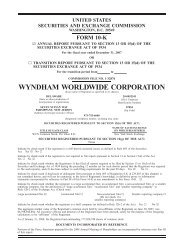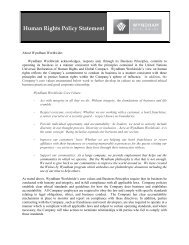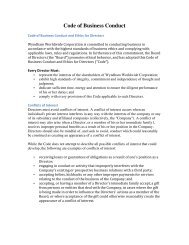WYNDHAM WORLDWIDE CORPORATION
WYNDHAM WORLDWIDE CORPORATION
WYNDHAM WORLDWIDE CORPORATION
You also want an ePaper? Increase the reach of your titles
YUMPU automatically turns print PDFs into web optimized ePapers that Google loves.
average exchange rates during the periods presented. The gains or losses resulting from translating foreign currency<br />
financial statements into U.S. dollars, net of hedging gains or losses and taxes, are included in accumulated other<br />
comprehensive income on the Consolidated Balance Sheets. Gains or losses resulting from foreign currency<br />
transactions are included in the Consolidated Statements of Operations.<br />
STOCK-BASED COMPENSATION<br />
In accordance with the guidance for stock-based compensation, the Company measures all employee stockbased<br />
compensation awards using a fair value method and records the related expense in its Consolidated Statements<br />
of Operations. The Company uses the modified prospective transition method, which requires that compensation cost<br />
be recognized in the financial statements for all awards granted after the date of adoption as well as for existing<br />
awards for which the requisite service has not been rendered as of the date of adoption and requires that prior<br />
periods not be restated.<br />
As of December 31, 2008, the Company had an APIC Pool balance of $4 million on its Consolidated Balance<br />
Sheet. During March 2009, the Company utilized its APIC Pool related to the vesting of restricted stock units<br />
(“RSUs”), which reduced the balance to $0 on its Consolidated Balance Sheet. During May 2009, the Company<br />
recorded a $4 million charge to its provision for income taxes on its Consolidated Statement of Operations related to<br />
additional vesting of RSUs. During 2010, the Company increased its APIC Pool by $12 million due to the vesting of<br />
equity awards. As of December 31, 2010, the Company’s APIC Pool balance was $12 million.<br />
EQUITY EARNINGS AND OTHER INCOME<br />
The Company applies the equity method of accounting when it has the ability to exercise significant influence<br />
over operating and financial policies of an investee. The Company recorded $1 million, $1 million and $4 million of<br />
net earnings from such investments during 2010, 2009 and 2008, respectively, in other income, net on the<br />
Consolidated Statements of Operations. In addition, during 2010, the Company recorded $6 million of income<br />
primarily related to gains associated with the sale of non-strategic assets at its vacation ownership business. During<br />
2009, the Company recorded $5 million of income primarily related to gains associated with the sale of nonstrategic<br />
assets at its vacation ownership and vacation exchange and rentals businesses. During 2008, the Company<br />
recorded $7 million of income primarily associated with the assumption of a lodging-related credit card marketing<br />
program obligation by a third-party and the sale of a non-strategic asset by the Company’s lodging business. Such<br />
amounts were recorded within other income, net on the Consolidated Statements of Operations.<br />
RECENTLY ISSUED ACCOUNTING PRONOUNCEMENTS<br />
Transfers and Servicing. In June 2009, the Financial Accounting Standards Board (“FASB”) issued guidance on<br />
transfers and servicing of financial assets. The guidance eliminates the concept of a Qualifying Special — Purpose<br />
Entity, changes the requirements for derecognizing financial assets, and requires additional disclosures in order to<br />
enhance information reported to users of financial statements by providing greater transparency about transfers of<br />
financial assets, including securitization transactions, and an entity’s continuing involvement in and exposure to the<br />
risks related to transferred financial assets. The guidance is effective for interim or annual reporting periods<br />
beginning after November 15, 2009. The Company adopted the guidance on January 1, 2010, as required. See<br />
Note 8 — Vacation Ownership Contract Receivables for additional disclosure required by such guidance.<br />
Consolidation. In June 2009, the FASB issued guidance that modifies how a company determines when an<br />
entity that is insufficiently capitalized or is not controlled through voting (or similar rights) should be consolidated.<br />
The guidance clarifies that the determination of whether a company is required to consolidate an entity is based on,<br />
among other things, an entity’s purpose and design and a company’s ability to direct the activities of the entity that<br />
most significantly impact the entity’s economic performance. The guidance requires an ongoing reassessment of<br />
whether a company is the primary beneficiary of a variable interest entity, additional disclosures about a company’s<br />
involvement in VIEs and any significant changes in risk exposure due to that involvement. The guidance is effective<br />
for interim or annual reporting periods beginning after November 15, 2009. The Company adopted the guidance on<br />
January 1, 2010, as required. See Note 8 — Vacation Ownership Contract Receivables for additional disclosure<br />
required by such guidance regarding the consolidation of the Company’s bankruptcy remote special purpose entities<br />
(“SPEs”) associated with its vacation ownership contract receivables securitizations.<br />
Multiple-Deliverable Revenue Arrangements. In October 2009, the FASB issued guidance on multiple-deliverable<br />
revenue arrangements, which requires an entity to apply the relative selling price allocation method in order to<br />
estimate selling prices for all units of accounting, including delivered items, when vendor-specific objective evidence<br />
or acceptable third-party evidence does not exist. The guidance is effective for revenue arrangements entered into or<br />
materially modified in fiscal years beginning on or after June 15, 2010 and shall be applied on a prospective basis.<br />
Earlier application is permitted as of the beginning of an entity’s fiscal year. The Company will adopt the guidance<br />
F-14







